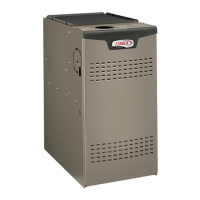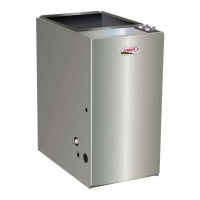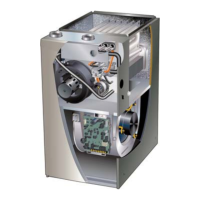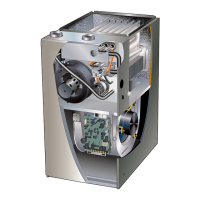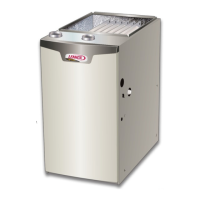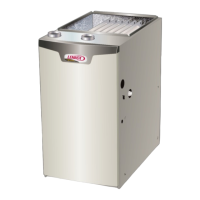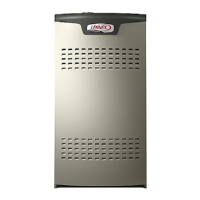Page 46
7HVWLQJ IRU 3URSHU 9HQWLQJ DQG 6XႈFLHQW
Combustion Air for Non-Direct Vent Applications
WARNING
CARBON MONOXIDE POISONING HAZARD!
Failure to follow the steps outlined below for each
appliance connected to the venting system being placed
into operation could result in carbon monoxide poisoning
or death. The following steps shall be followed for each
appliance connected to the venting system being placed
into operation, while all other appliances connected to
the venting system are not in operation.
After the EL196UHE gas furnace has been started, the
following test should be conducted to ensure proper vent-
LQJDQGVXႈFLHQWFRPEXVWLRQDLUKDVEHHQSURYLGHGWRWKH
(/8+(DVZHOODVWRRWKHUJDV¿UHGDSSOLDQFHVZKLFK
are separately vented.
If a EL196UHE furnace replaces a Category I furnace
which was commonly vented with another gas appliance,
WKH VL]H RI WKH H[LVWLQJ YHQW SLSH IRU WKDW JDV DSSOLDQFH
must be checked. Without the heat of the original furnace
ÀXHSURGXFWVWKHH[LVWLQJYHQWSLSHLVSUREDEO\RYHUVL]HG
for the single water heater or other appliance. The vent
should be checked for proper draw with the remaining ap-
pliance.
The test should be conducted while all appliances (both
in operation and those not in operation) are connected to
the venting system being tested. If the venting system has
been installed improperly, or if provisions have not been
PDGHIRUVXႈFLHQWDPRXQWVRIFRPEXVWLRQDLUFRUUHFWLRQV
must be made as outlined in the previous section.
1 - Seal any unused openings in the venting system.
9LVXDOO\LQVSHFWWKHYHQWLQJV\VWHPIRUSURSHUVL]HDQG
KRUL]RQWDOSLWFK'HWHUPLQH WKHUH LV QR EORFNDJH RU
UHVWULFWLRQOHDNDJHFRUURVLRQRURWKHU GH¿FLHQFLHV
which could cause an unsafe condition.
3 - To the extent that it is practical, close all building
doors and windows and all doors between the space
in which the appliances connected to the venting
system are located and other spaces of the building.
&ORVH¿UHSODFHGDPSHUV
5 - Turn on clothes dryers and any appliances not
connected to the venting system. Turn on any
exhaus fans, such as range hoods and bathroom
exhausts, so they will operate at maximum speed.
Do not operate a summer exhaust fan.
6 - Follow the lighting instruction to place the appliance
being inspected into operation. Adjust thermostat so
appliance will operate continuously.
8VHWKHÀDPHRIPDWFKRUFDQGOHWRWHVWIRUVSLOODJH
RIÀXHJDVHVDWWKHGUDIWKRRGUHOLHIRSHQLQJDIWHU
minutes of main burner operation.
8 - If improper venting is observed during any of the
above tests, the venting system must be corrected
RU VXႈFLHQW FRPEXVWLRQPDNHXS DLU PXVW EH
SURYLGHG 7KH YHQWLQJ V\VWHP VKRXOG EH UHVL]HG
WR DSSURDFK WKH PLQLPXP VL]H DV GHWHUPLQHG E\
using the appropriate tables in appendix G in the
current standards of the National Fuel Gas Code
ANSI-Z223.1/NPFA 54 in the U.S.A., and the
appropriate Natural Gas and Propane appliances
YHQWLQJ VL]LQJ WDEOHV LQ WKH FXUUHQW VWDQGDUG RI WKH
CSA-B149 Natural Gas and Propane Installation
Codes in Canada.
9 - After determining that each appliance remaining
connected to the common venting system properly
events when tested as indicated in step 3, return
GRRUV ZLQGRZV H[KDXVW IDQV ¿UHSODFH GDPSHUV
and any other gas-burning appliance to their previous
condition of use.
Other Unit Adjustments
Primary Limit.
The primary limit is located on the heating compartment
vestibule panel. This limit is factory set and requires no
adjustment.
Flame Rollout Switches (Two)
These manually reset switches are located in the burner
box.
Pressure Switch
The pressure switch is located in the heating compartment
on the cold end header box. This switch checks for proper
combustion air inducer operation before allowing ignition
trial. The switch is factory-set and must not be adjusted.
Temperature Rise
After the furnace has been started and supply and return
DLUWHPSHUDWXUHVKDYHEHHQDOORZHGWRVWDELOL]HFKHFNWKH
temperature rise. If necessary, adjust the blower speed
to maintain the temperature rise within the range shown
on the unit nameplate. See TABLE 17 on page 54 for
allowable heating speeds. Increase the blower speed to
decrease the temperature. Decrease the blower speed to
increase the temperature rise. Failure to adjust the tem-
perature rise may cause erratic limit operation.
Fan Control
Fan On Delay
The heat fan on time of 30 seconds is not adjustable. The
cool fan on delay is 2 seconds and not adjustable.
)DQ2௺'HOD\
7KH KHDW IDQ Rႇ GHOD\ DPRXQW RI WLPH WKDW WKH EORZHU
RSHUDWHVDIWHUWKHKHDWGHPDQGKDVEHHQVDWLV¿HGPD\
be adjusted by changing the jumper position across the
¿YHSLQVRQWKHLQWHJUDWHGFRQWURO7KHXQLWLVVKLSSHGZLWK
DIDFWRU\IDQRႇVHWWLQJRIVHFRQGV7KHIDQRႇGHOD\
DႇHFWVFRPIRUWDQGLVDGMXVWDEOHWRVDWLVI\LQGLYLGXDODS-
SOLFDWLRQV$GMXVWWKHIDQRႇGHOD\WRDFKLHYHDVXSSO\DLU
temperature between 90° and 110°F at the moment that
WKHEORZHULVGHHQHUJL]HG/RQJHURႇGHOD\VHWWLQJVSUR-
vide lower return air temperatures; shorter settings pro-
vide higher return air temperatures. See Figure 62. The
FRROIDQRႇGHOD\DPRXQWRIWLPHWKDWWKHEORZHURSHUDWHV
DIWHUWKHFRROGHPDQGKDVEHHQVDWLV¿HGLVVHFRQGV
and not adjustable.
